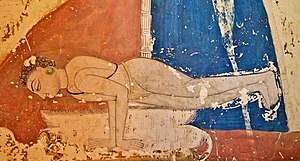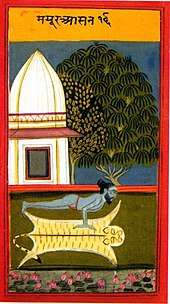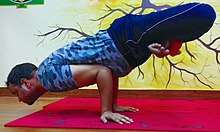Mayurasana
Mayūrāsana (Sanskrit: मयूरासन) or Peacock pose[1] is a hand-balancing asana in hatha yoga and modern yoga as exercise with the body held horizontal over the hands.


Etymology and origins

The name comes from the Sanskrit words mayūra (मयूर) meaning "peacock"[2] and āsana (आसन) meaning "posture".[3]
Mayurasana is one of the oldest non-seated asanas used in hatha yoga; it is first described in the 10th century Vimānārcanākalpa. The Vāsiṣṭha Saṁhitā 1.76-7 states that it destroys all sins.[4]
Description
In this asana the body is raised like a horizontal stick holding the floor with both palms while the body is supported by the elbows.[5]
Variations
Hamsasana (Swan Pose) is identical to Mayurasana except that the hands are placed with the fingers pointing forwards.[6]

Padma Mayurasana (Lotus in Peacock Pose) has the legs crossed as in Lotus Position.[7]
Claims
Twentieth century advocates of some schools of yoga, such as B. K. S. Iyengar, made claims for the effects of yoga on specific organs, without presenting any evidence.[8][9] Iyengar claimed that this pose "tones up the abdominal organs wonderfully", and that the elbow pressure on the abdominal aorta made blood circulate "properly in the abdominal organs".[10] He claimed further that the pose improved digestion, cured stomach and spleen illnesses, and prevented "toxins" from accumulating.[10] He stated also that it would be of benefit in diabetes.[10]
See also
- List of asanas
- Planche (exercise)
- Vrischikasana, scorpion pose, with variations including Pincha Mayurasana
References
- "Yoga Journal - Peacock Pose". Retrieved 9 April 2011.
- "Mayurasana - AshtangaYoga.info". Retrieved 9 April 2011.
- Sinha, S. C. (1 June 1996). Dictionary of Philosophy. Anmol Publications. p. 18. ISBN 978-81-7041-293-9. Retrieved 9 April 2011.
- Mallinson, James; Singleton, Mark (2017). Roots of Yoga. Penguin Books. pp. 100–101, 105. ISBN 978-0-241-25304-5. OCLC 928480104.
- Iyengar 1979, pp. 282–284.
- Iyengar 1979, pp. 284–285.
- Ramaswami, Srivatsa; Krishnamacharya, T. (3 June 2005). The complete book of vinyasa yoga: an authoritative presentation, based on 30 years of direct study under the legendary yoga teacher Krishnamacharya. Da Capo Press. p. 208. ISBN 978-1-56924-402-9. Retrieved 9 April 2011.
- Newcombe 2019, pp. 203-227, Chapter "Yoga as Therapy".
- Jain 2015, pp. 82–83.
- Iyengar 1979, p. 284.
Sources
- Iyengar, B. K. S. (1979) [1966]. Light on Yoga: Yoga Dipika. Unwin Paperbacks. ISBN 978-1855381667.CS1 maint: ref=harv (link)
- Jain, Andrea (2015). Selling Yoga : from Counterculture to Pop culture. Oxford University Press. ISBN 978-0-19-939024-3. OCLC 878953765.CS1 maint: ref=harv (link)
- Newcombe, Suzanne (2019). Yoga in Britain: Stretching Spirituality and Educating Yogis. Bristol, England: Equinox Publishing. ISBN 978-1-78179-661-0.CS1 maint: ref=harv (link)
_from_Jogapradipika_1830_(detail).jpg)
